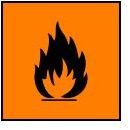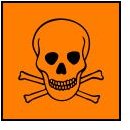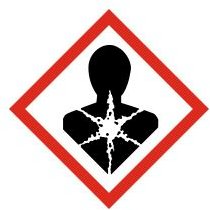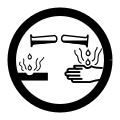Examples of Mutagens and Other Hazardous Substances in the Environment
It’s a Matter of Human Health
Hazardous substances are the chemical elements known as persistent organic pollutants (POP) found in the environment as they are used by different industries in manufacturing and by agricultural sectors. These hazardous substances are classified as “priority list” because they tend to have the most potential threat to the environment and to human health. The matter of threat would mean constant exposure or prevalence in the atmosphere to cause harm to human health and wildlife, contamination in water and its sources as well as pollution in air and soil. Due to this, employers and workers are advised to have awareness about the different types of hazardous substances for control, prevention and avoidance.
They are categorized into four types: corrosive, flammable or ignitable, reactive or combustible and toxic. As toxic hazardous substances, they are further categorized as anesthetics, asphyxiants, sensitizers, carcinogens, mutagens and teratogens.
CORROSIVES
Hazardous substances are considered corrosives if they have the ability to eat through metal, burn human or animal skin upon contact and exude vapors or fumes that can cause stinging or burning sensation to the eyes. Examples of hazardous substances that are corrosive are:
Fluoroantimonic Acid - This is also known as super acid because of its strength and capability to burn through anything, including substances that are not supposed to react to acid. It is a combined mixture of antimony pentafluoride and hydrogen fluoride. According to research studies, it is said to be 20 quintillion times more potent than sulfuric acid. This super acid can be found in industries that require chemical reactions in order to achieve transformation, as in the refinement of crude oil into high-octane gasoline or the transformation of oil shale into crude oil. They can also be found in industries involved in the manufacture of plastics.
Hydrochloric Acid - is commercially known as muriatic acid and is considered to be one of the most versatile and important chemical compound in manufacturing industries. Hydrochloric Acid is chlorine gas burned in hydrogen to produce hydrogen chloride (HCl). HCl, when combined with water, will release hydronium ions to form hydrochloric acid and become commercially available into two grades; the technical grade, which has concentrations of 35-38% and the commercial grade known as muriatic acid, with concentrations of 30-32%. In industries, the technical grade is used in metals, electroplating, in activating geothermal oil wells, processing of electronic products and manufacture of fertilizers and dyes. In the food industry, HCl is used for processing starch, glucose and protein. Muriatic acids are popularly used in households as effective stain removers for floor tiles as well as other kitchen and bathroom fixtures.
Sulfuric Acid - This substance is also known as _oil of vitriol or vitrio_l and is industrially processed by dissolving sulfur trioxide in water. Once it is made to reach saturation point, it becomes fuming sulfuric acid known as oleum to be used in processing other organic chemicals. Sulfuric acid is also considered one of the most important chemicals in industrial sectors utilized in manufacturing dyes, pigments, fertilizers, detergents, explosives, inorganic salts and acid. It is also the main acid substance in lead-acid storage batteries. Other uses can be found in the petroleum refining industries and metallurgical processing.
Nitric Acid - This hazardous substance is highly corrosive, can have the properties of fuming corrosive liquid and is considered an inorganic compound. Its importance can be found in industries involved in the manufacture of fertilizers and explosives, as well as in the reprocessing of spent nuclear fuel. It is commercially used for steel etching and photoengraving.
Please proceed to the next page for descriptions regarding other types of hazardous substances to our environment.
FLAMMABLE / IGNITABLE

A hazardous substance is considered flammable or ignitable if it easily bursts into flames and possesses certain qualities of a fire hazard. Aerosols are considered flammable when it yields a flame projection of more than 18 inches when subjected to a test method called 16 CFR 1500 45 with the full valve opened. Some liquid substances can be flammable by having a flash point at 100 °F, while some flammable liquids are mixtures that have flash points of 141 °F or higher. Gasoline and solvents are easily identifiable as flammable hazardous substances but you might not be aware that some food, metal dusts and wood also possess ignitable compositions.
A substance is flammable or becomes flammable if there are three elements present: oxygen, fuel and igniter as in the form of heat. Keep in mind that oxygen is always present since it is always in the atmosphere. The igniter will provide the spark to initiate the fire, while fuel will keep the flame burning. Examples of igniters are flying or stationary sparks, open flames, static electricity, friction, heat, welding arc, cigarette butts with embers, pilot light and similar ignition sources.
As your guide, flammable substances like gasoline, acetone, ammonia, ethylene oxide and pentane are all liquid hazardous substances; acetylene, propane, carbon monoxide are gaseous forms while solids like rubber, plastic, wood, packaging, textiles, plastic foams, wood dust, sugar dust and flour dust are also flammable. In case fire or explosion does occur, immediately smother the fire with a thick blanket or non-flammable material to remove oxygen since fire cannot be sustained in the absence of this element.
REACTIVE OR COMBUSTIBLE

A reactive or combustible hazardous substance has a tendency to form into poisonous gas or explode when combined with another chemical. One good example is chlorine bleach which becomes reactive and will create a poisonous substance if combined with ammonia. Other examples of reactive or combustible hazardous substances are linseed oil as paint ingredient, oily cotton waste, carbon, copra and white phosphorus which react when it comes in contact with air. Some chemicals are known to be water-reactive like alkali metals, alkaline earth metals, anhydrides, hydrides, sodium hydrosulfite and aluminum phosphide.
It is important for workers to know the water-reactive and air-reactive materials they are handling, which may even include cleaning materials that are combustible. Storing them in wet conditions should be avoided or making sure that they are kept in compatible containers that have equal strength should be observed. Learning of these water-reactive combustible materials is also important, this is to avoid using water when attempting to douse the fire. Making use of an appropriate Class D Fire Extinguisher is the safe option.
TOXIC/POISONOUS

Persistent organic pollutants that are toxic have become widespread and varied; hence, the examples given below are according to their manner of toxicity or toxic behavior. This is important especially in workplaces or occupations that involve printing, painting, coating and the manufacture of paints or coats, degreasing, dry cleaning, dye workers, crafting as in the application of glues and similar solvents, carpentry, textile making, airplane refitting, refining as well as handling of polymers, pharmaceuticals and agricultural products. The following are the sub-classifications of toxic substances:
Anesthetic /De-sensitizing/ Paralyzing- which means the toxic or hazardous substance can cause numbness to the point of impairing mind and body functions. De-sensitizing substances are often found in solvents like n-hexane, methyl butyl ketone and carbon disulfide.
Asphyxiants- The most common asphyxiants are carbon monoxide which causes blockage that prevents the exchange of oxygen in the body. Another most common example is the combination of bleach and ammonia wherein oxygen displacement causes distress in the respiratory system.
**Sensitizers –**are hazardous substances that cause allergic reactions like formaldehyde, algicides and similar biological agents, baker’s yeast and isocyanate-based foam products. These are also present in spores, molds and mildew as they contain mycotoxins whose severity can affect persons who do not have allergies. Mold spores may appear on your walls as they emanate from volatile organic compounds (VOC) or materials that have been exposed to high humidity that produce moisture, that promotes spore or mold growth.
Please proceed to the next page for the continuation of other toxic substances.
Continuation of Descriptions for Toxic and Hazardous Substances

Carcinogens- are cancer causing agents found in asbestos, cigarette smoke, genetically modified foods, benzene and other substances that are labeled and marked with the risk indicators R40, R45 or R49. The most common carcinogenic substances can be found in workplaces, consumer products, pet products and even food products. Examples of carcinogenic chemicals and substances are formaldehyde, paradichlorobenzene commonly encountered as ingredient in toilet bowl cleaners, _perchloroehtylen_e commonly found in dry-cleaning fluids, carpet cleaners and spot removers, dichlorophenooxyacetate and sodium 2 which are pesticide ingredients, quarterium 15, FD & C Red 40, phenol fluoride, and a host of other chemical substances as well as tobacco or cigarette smoke and smog.
Mutagens- are substances that can alter the structure or makeup of cells or the DNA which can be caused by electromagnetic radiation like x-rays, cosmic rays, gamma rays and ultraviolet light. Mutagens are different from carcinogens since some mutagens do not cause cancer in humans but only in animals. They often lead to the creation of free radicals inside a cell which can cause damage to the DNA. However, it has been scientifically observed that DNA is constantly damaged but can also be constantly repaired.
**Teratogens-**These are substances called feto-toxic substances or reprotoxins. They tend to influence the fertility in both male and female as they affect the sperm or egg cells. Prevention or caution should apply not only during pregnancy or breast feeding but even before the child reproduction and bearing stage. These substances should have proper labels and clearly marked with the indicators like: R60 (damage fertility); R61 (damage an unborn child); R62 (dangers of decreasing fertility); R63 (can possibly bring about damage to an unborn child) and R64 (can possibly bring about damage by way of breast-feeding).
Examples are ethylene glycol ethers used in the semi-conductor industry, paint manufacture or maintenance. Tetracholoroethylene, xylene, toluene, styrene, acetone, benzene and methylene chloride, butanol and isopropanol are only a few of the organic and inorganic chemical substance found in industrial workplaces considered as teratogens.
Database For Verifying Information About Toxic Hazardous Substances
Obviously, the list of types of hazardous substances is quite long yet still incomplete. A tool you could use in case you need to research or verify certain chemical substances is the Environmental Protective Agency’s (EPA’s) Toxic Reference Database (ToxRefDB).
Reference Materials:
-
https://www.mom.gov.sg/publish/etc/medialib/mom_library/Workplace_Safety/probe_flammable_hazardous.ar.25017.File.tmp/Technical%20Advisory%20for%20Flammable%20Hazardous%20Substances.pdf
-
https://actrav.itcilo.org/actrav-english/telearn/osh/kemi/ctm4a.htm
-
https://www.utwente.nl/pao/en/info_voor/medewerkers/Arbo%20en%20milieu/gevaarlijke%20stoffen/Werken%20met%20kankerverwekkende%20en%20reprotoxischestoffen_EN.doc/
Images Courtesy of Wikimedia Commons
This post is part of the series: All About Hazardous Materials and the Environment
The public’s awareness about the hazardous materials being used in different industry sectors is important. Knowing the different types of hazardous substances and the cons of hazardous wastes will instill the need to take extra precautions in the handling and disposal of these materials.
